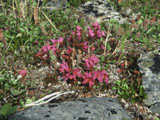Native Plants

Q. Who is Mr. Smarty Plants?
A: There are those who suspect Wildflower Center volunteers are the culpable and capable culprits. Yet, others think staff members play some, albeit small, role. You can torture us with your plant questions, but we will never reveal the Green Guru's secret identity.
Did you know you can access the Native Plant Information Network with your web-enabled smartphone?
Ask Mr. Smarty Plants is a free service provided by the staff and volunteers at the Lady Bird Johnson Wildflower Center.

rate this answer
Friday - August 15, 2008
From: Brooklyn, NY
Region: Northeast
Topic: Non-Natives, Shade Tolerant, Shrubs, Trees
Title: Japanese maple in New York
Answered by: Nan Hampton
QUESTION:
I have a few questions: Do you know what zone Brooklyn, NY. is in? If I plant a Japanese Maple in my backyard, do you think it can tolerate almost full shade (1-2 hours of sun per day)? Also, is it really true that rhododenren require morning sun? I want to plant 2 of them in areas that get 1-2 hours sun in the in the late afternoon. Thanks VERY Much!ANSWER:
USDA Plant Hardiness Zone Map shows that Brooklyn is either in Zone 7a or 6b. The average minimal temperatures are 0 to 5° F for 7a and -5° to 0 F for 6b.
Acer palmatum (Japanese maple) as the name suggests is native to Asia, not North America. Since our area of expertise is plants native to North America we can't really furnish you with firsthand knowledge about the growing requirements of Japanese maple, but we're happy to point you to some information that can help you. Information from Ohio State University and The Garden Helper indicates that the Japanese maple does well in light or partial shade. Some cultivars will tolerate full sun. WorldPlants.com indicates that there are also cultivars that will do well in shade.
We are a bit more knowledgeable about Rhododendrons since there are more than 25 species native to North America and 8 of those are native to New York:
Rhododendron arborescens (smooth azalea)
Rhododendron calendulaceum (flame azalea)
Rhododendron canadense (rhodora)
Rhododendron lapponicum (Lapland rosebay)
Rhododendron maximum (great laurel)
Rhododendron periclymenoides (pink azalea)
Rhododendron prinophyllum (early azalea)
Rhododendron viscosum (swamp azalea)
All of these will grow in partial shade although several hours of sun per day will probably keep them from becoming 'leggy' and will also produce more blooms. Morning sun is preferable to afternoon sun—the disadvantage of the afternoon sun compared to morning sun is the elevated temperature that accompanies the afternoon sun. Since your area receives very little afternoon sun and temperatures are generally not extreme where you live, I would think that your rhododentrons would do fine. Here are some general tips from Flower Gardening Made Easy.
More Non-Natives Questions
A method for killing nandina and ligustrum with herbicide
October 19, 2012 - Is there an effective herbicide that can be painted on the stumps of Nandina and Wax-leaf ligustrum to keep them from growing back?
Thanks so much!
view the full question and answer
Replacing non-native invasives with native grasses and wildflowers from Round Rock TX
April 04, 2012 - I have a small piece of property (1.5 AC) East of Austin, Texas that get's overgrown with weedy vegetation (johnson grass, dandelion, and some tall yellow flowering plant that I see all over the medi...
view the full question and answer
Fruit fly maggots attacking non-native Grumichama in Lake Worth FL
March 12, 2011 - Dear Mr. Smarty Plants
How do I prevent fruit fly maggots from attacking my Grumichama fruit?
view the full question and answer
Differences between Lantana urticoides and Lantana camara
July 13, 2012 - I have found an orange variety of lantana growning in several location in Jefferson County. Is there any way I can tell for sure if it is L. camara or the native L. urticoides?
view the full question and answer
Non-native creeping fig and non-native nutgrass in Carmichael CA
September 28, 2009 - Will creeping fig choke out nut grass?
view the full question and answer
| Support the Wildflower Center by Donating Online or Becoming a Member today. |

